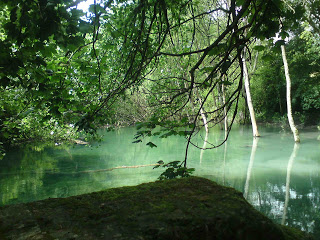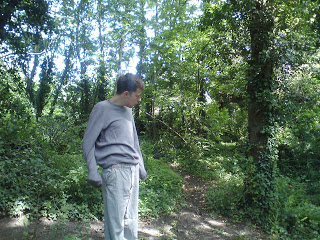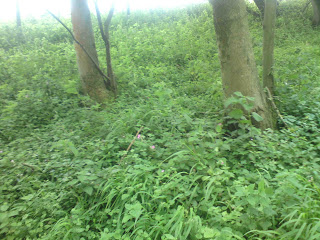Opening up the South Downs National Park
 |
| Chanctonbury Ring, December 2004 |
Two weeks ago the Downlanders, a group which seeks to maximise the use of the newly created South Downs National Park, walked from a small town Steyning in West Sussex to Chanctonbury Ring and back again. I went along with my son, Daniel, although I wasn’t sure I’d make it as I still have a broken toe (from the counter EDL demonstration!).
Below is a description from Wikipedia of Chanctonbury Ring and from local environmentalist and socialist author, Dave Bangs as well as some
.
Chanctonbury Ring (known as Chanklebury in Sussex dialect)[1] is a hill fort based ring of trees atop Chanctonbury Hill on the South Downs, on the border of the civil parishes of Washington and Wiston in the English county of West Sussex. A ridgeway, now part of the South Downs Way, runs along the hill. Bertrand Russell once remarked that “any view that includes Chanctonbury Ring is a good view”.
Chanctonbury Ring was originally a small hill fort in a commanding position looking across the weald to the north. Pottery found and carbon dating on an animal bone suggest the fort was built in the early Iron Age, in the 6th to 5th centuries BC, but some Bronze Age pottery has also been found on the site.
Roman temples
After the abandonment of the hill fort, the ring was used by the Romans as a religious site (possibly due to similar Iron Age religious activity there). Two temples were erected, although it is not clear whether they stood at the same time or whether one succeeded the other. One, of Romano-British type with towered central sanctuary and outer ambulatory, certainly dated from the later Roman period. The second Roman temple may have been earlier and was more classical in form and consisted of a polygon of perhaps eleven sides. Human remains approximately one thousand years old have also been found there.
The fame of the Ring, however, is due not to the hill fort but to the beech trees, which were planted in 1760 by Charles Goring within the earth bank of the fort,[2] which is still prominent today. The trees became a prominent landmark, very thickly wooded; however, the Great Storm of 1987 destroyed most of the trees and the replanted trees are only now beginning to restore the ring to its former glory.
Walk to Chanctonbury Ring
This walk takes in three of the best sites on the Brighton Downs, including one which was famous for a 100 years after 1840, and one which is of National Nature Reserve standard (though it isn’t one). It includes two sites which are still – contrary to the law – ‘inaccessible Access Land’ five years after their designation. One of them is farmed by a Tory councillor.
We will start by exploring Anchor Bottom, so called because ships anchored on the Adur below. It is a half-mile-long delight so lovely that superlatives are superfluous !!! This is a place which still has the magic of the old Downs before capitalist agribusiness did its worst, with its soft velvety curved slopes covered in aboriginal Down pasture. It has masses of colourful Waxcap and Rockrose fungi (& the rains mean we may see some), dancing clouds of Adonis and Chalkhill Blues, Yellowhammer, Linnet, and Meadow Pipit, distant views to Chanctonbury and Blackdown in the dim blue goodness of the Weald, across the Adur’s silver meanders…and with nice views of the huge Beeding Chalkpit, with its Peregrines, Owls, Big Cat, Ravens and multi-millions of years of exposed geological history.
After climbing the combe head to the Beeding Hill car park we then have to yomp across the desperate desolation of old Beeding Hill common (enclosed 120 years ago), once a haunt of Nightingales and the ghosts of the ancient peoples, and now a tedious stretch of improved pastures, after half a century of arable cropping.
Our walking brings us, however, to Thundersbarrow Hill and its Iron Age encampment and Romano-British village, as well as the still-substantial remains of the Thundersbarrow itself. Let’s hope Thor doesn’t thunder.
We will then descend westwards down ‘Thunder’s Steps’ to the relict chalk grassland site on the east side of Mossy Bottom (which used to be ‘Muster Bottom’, much more sensibly). This is an ‘inaccessible Access Land’ site – still wired off from public access, perhaps because it has two pheasant rearing pens in its thickets.
From this quiet spot we will traverse westwards through New Erringham Farm, over the Beeding Hill road and down into the blessed tranquility of Old Erringham Combe, our second ‘inaccessible Access Land’ site. I was challenged here by two clay pigeon shooting berks last Saturday and told that it was not Access Land. How much longer will we have to put up with this nonsense ??
This is a gorgeous site with an abundance of peace and Downland rarities. I found Lesser Centaury here last week, which otherwise on these Downs is only found on the Dyke/Newtimber Hill/Wolstonbury promontories. Clouded Yellow had arrived from the Continent, with large numbers of Small Heath, the occasional Chalkhill and Adonis, and Dusky Sallow, (which I have often seen there). The combe is one of the last Downland sites for the rapidly declining Carthusian Snail, Monacha cartusiana.
Distant views of Lancing College Chapel, Applesham Farm and the old wooden Toll Bridge at Old Shoreham.
From here we pass through Old Erringham Farmstead, (with its Norman chapel, anti-Viking fortifications and ancient manor house) and pass onto the famous Mill Hill Local Nature Reserve. This site was hunted over by generations of Victorian lepidopterists looking for varieties of Chalkhill and Adonis. These butterflies were, though, almost lost in the last century by the site’s dereliction, and only the vigorous intervention of conservationists saved them.
Doing our best to ignore the din from the A27 we will gently descend to Old Shoreham and the bus home. There are many, many special things I have not mentioned. If the weather holds this walk should be a real treat!!
Dave Bangs










